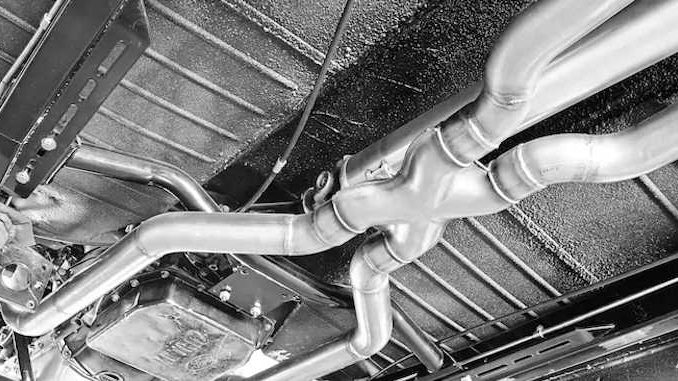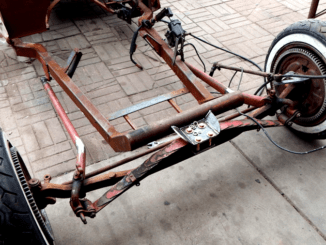
The tables below are basic references to help guide you to the exhaust-pipe size needed to balance the prevention of excessive back-pressure while maintaining adequate exhaust-gas velocity.
Editor’s Note: The easy to read tube size charts replace our original exhaust diameter calculator for ease of use.
| Engine Displacement | HP | Pipe Diameter for Single Exhaust System | Pipe Diameter for Dual Exhaust System |
| 150-200 | 100 | 2.0 | 2.0 |
| 150 | 2.25 | 2.0 | |
| 200 | 2.5 | 2.0 | |
| 200-250 | 150 | 2.25 | 2.0 |
| 200 | 2.5 | 2.0 | |
| 250 | 2.5 | 2.25 | |
| 250-300 | 200 | 2.5 | 2.0 |
| 250 | 2.5 | 2.25 | |
| 300 | 3 | 2.5 | |
| 300-350 | 250 | 3.0 | 2.25 |
| 300 | 3.0 | 2.5 | |
| 350 | 3.5 | 2.5 | |
| 350-400 | 300 | 3.0 | 2.5 |
| 350 | 3.5 | 2.5 | |
| 400 | 4.0 | 3.0 | |
| 400-450 | 350 | 3.5 | 2.5 |
| 400 | 4.0 | 3.0 | |
| 450 | 4.0 | 3.0 | |
| 450-500 | 400 | 4.5 | 3.5 |
| 450 | 4.5 | 3.5 | |
| 500 | 4.5 | 3.5 |
Quick Exhaust System Math
Easy Way To Estimate: Your intake system needs to flow 1.5 CFM per engine horsepower, and your exhaust system needs to flow 2.2 CFM per engine horsepower.
Good Way To Estimate: Take engine RPM x engine displacement, then divide by two. This is the intake volume. Use this same volume of air for the exhaust system, but then correct for thermal expansion (you need to know exhaust temps to figure things out).
Exhaust Pipe Size Estimate: A good section of straight pipe will flow about 115 CFM per square inch of area. Here’s a quick table that shows how many CFM each common pipe size will flow, as well as the estimated max horsepower for each pipe size:
| Pipe Diameter (inches) | Pipe Area (in2) | Total CFM (est) | Max HP Per Pipe | Max HP For A Dual Exhaust System |
| 1 1/2 | 1.48 | 171 | 78 | 155 |
| 1 5/8 | 1.77 | 203 | 92 | 185 |
| 1 3/4 | 2.07 | 239 | 108 | 217 |
| 2 | 2.76 | 318 | 144 | 289 |
| 2 1/4 | 3.55 | 408 | 185 | 371 |
| 2 1/2 | 4.43 | 509 | 232 | 463 |
| 2 3/4 | 5.41 | 622 | 283 | 566 |
| 3 | 6.49 | 747 | 339 | 679 |
| 3 1/4 | 7.67 | 882 | 401 | 802 |
| 3 1/2 | 8.95 | 1029 | 468 | 935 |
NOTE: These numbers are just estimates. All pipes are assumed to be 16 gauge steel.
Exhaust Component Sizing and Fitting ~ ID vs OD
Learn about how individual exhaust components are measured, fit together, and what tools and techniques you’ll need to put together a well-fitted, leak-free, custom exhaust system.
Carl Pritts, a tech adviser at Summit Racing, explains inner diameter (I.D.) vs. outer diameter (O.D.) measurements and shows various clamp and joint options, depending on your particular components…
Exhaust Back Pressure and Tube Diameter
Learn about back pressure, how it works and why it is important to your engine.
Al will also give you a break down of which diameter exhaust tubing you should choose depending on if you choose a single or dual exhaust and the horsepower of your engine.




